Maintaining our extra Olympic buses during the Games
Maintaining our extra Olympic buses during the Games
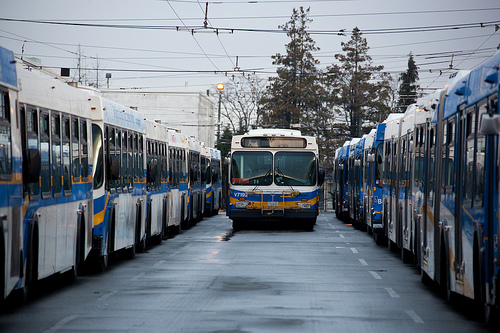
Yes, the Olympics are over, but I still have a couple of articles left to share about our work! This article is by Charlotte Boychuk from CMBC’s employee communications team, and it recognizes the great work of our bus maintenance staff. And for a bit of context, part of our old Vancouver bus depot, Oakridge Transit Centre (OTC), was reactivated in order to store and maintain the extra 160 buses we used for the Olympic period. (Normally, OTC houses just CMBC’s trolley overhead department and some of our Community Shuttle fleet.)
Behind the Scenes with Maintenance at OTC ‘Olympic Central’
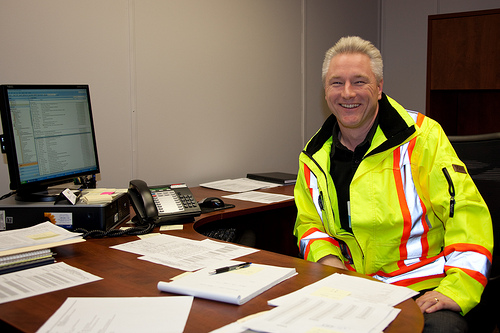
If you want to track down Jack, Burnaby Transit Centre (BTC) Maintenance Manager, he can be found at night and well into the morning during the Olympic period assisting Alan at Oakridge Transit Centre (OTC), who manages the garage on a day-to-day basis.
Jack and Alan oversee the Olympic fleet, consisting of 129 conventional and 20 community shuttle buses, currently used to augment our fleet of ‘Specials’ serving the various Olympic venues.
Together they work with the Special Work Team (SWT) and OTC Mechanics to help maintain the fleet.
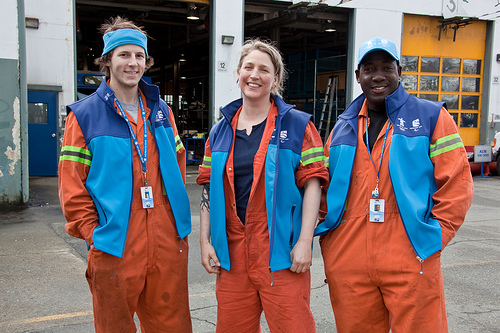
The SWT mechanics are a group of floating mechanics that fill in at any garage as needed. Currently they are providing coverage around the clock on three shifts at OTC, ready to fix any of the Olympic fleet that comes in for minor repairs such as broken lights, mirrors, or other ‘quick fixes’ under two hours.
If buses require major repairs, Fleet Overhaul and the other Maintenance garages are standing by ready to help.
“We are well set-up to provide quick turnaround to prevent cancellations or breakdowns. ” said Jack, “thanks to a great deal of planning that went on ahead of time.”
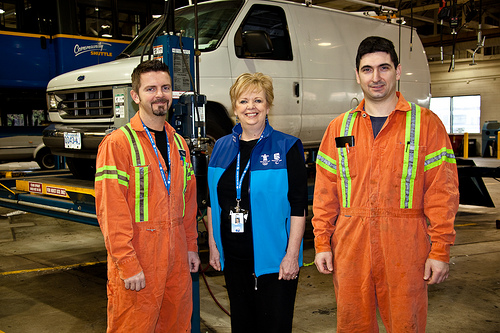
Mechanics Vince and Steve, who regularly maintain the non-revenue vehicles, such as service, shop, line and parts delivery trucks; pool cars; and tractor trailers, are also assisting with Olympic fleet repairs as required.
Shop Clerk Wendy Henschel said OTC is very busy right now with the added new mechanics and nine additional interior student cleaners.
Most of the Olympic fleet consists of retired Orions and New Flyer buses brought back from storage for the Olympics. A Special Work Team inspected the buses over a two-week period, starting them up, changing oil, checking the electrical, replacing batteries and ensuring they were road safe. Any larger repairs were sent off to Fleet Overhaul or the other depots.
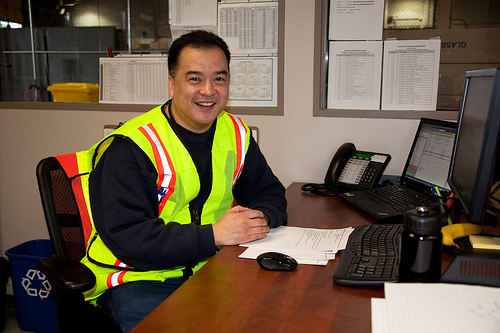
Lewis, a Maintenance Planner, is on-site to ensure that maintenance is not missed and work orders are complete on the Olympic fleet as quickly as possible.
Lewis explained that “although the fleet was inspected, we’re keeping a close eye on the buses to make certain nothing gets overlooked.”
The odd bus has had some minor problem such as bulbs out, a burst hose or farebox issues. “We even had to replace a seat, which someone decided to take as perhaps an Olympic token.”
Because the majority of the buses are coming back to the Depot later than initially anticipated, they still have to be booked-out to get ready for the next day.
Things are done a little different at OTC each morning. Before going into service, Operators take the buses out after doing pre-trip inspections them on the property. They are then driven to VTC to be fueled, washed, and to have their fareboxes prepared for the next day, all of which takes approximately 15 minutes.
According to Jack, the fleet has worked out very well and our mechanics have done a great job getting these buses ready to go.






Were these buses (the retired ones that were reactivated) kept longer that usual with the intent to use them during the Olympics? Or does Translink keep the newest retired buses on hand for emergencies/special events? Are these buses usually sold off? I know that some our trolly buses were recently sold of to Argentina(?) is this also normal practice for the diesel/NG buses as well?
Why was there a mini van on the hoists at OTC? Are these buses going to stay in service since they have been repaired or will they be put back into storage?
I asked you two questions in the “#5 reroute post” can you answer them for me?
Ric: Again, please be patient! You really don’t need to tell me every time that you have asked a question — I see them all come in and will work on getting answers for you. Please be conscious that it also may take a little while to get answers so the responses may not be immediate. So in short: don’t worry, I am hearing you! :)
Jhen, Does it sometimes take more then 1 day for you to get questions answered? A well why are some questions never answered?
Ric: calm down! It almost sounds like you’re complaining.
I don’t think one should expect all their questions to be answered at all. One shouldn’t monopolize the blog space with so many questions, only to be so persistent that questions must be answered in a specific time frame.
Ric:
Yes, questions can certainly take more than one day to get answers. I send everyone’s questions to staff at TransLink and its family of companies to ensure I have the right responses, and depending on how busy everyone is, how inclined someone is to respond, or how complex the question is, it can take anywhere from 5 minutes to several weeks at the extreme ends. Most are answered within a couple of days, though.
If questions are missed, it’s either a) an oversight on my part or b) someone has not responded to me with the answer. Please be aware that I am the only person maintaining this blog—both fetching answers to your questions and writing the original content that appears every day—and that’s in addition to editing the Buzzer newsletter and my work on other TransLink projects. I also only work roughly from 8:30 to 4:30 on weekdays, so answering is limited to those hours. However, I do try my best to capture and answer everything that comes in though, and your patience is of course appreciated on that end. For the most part, I am pretty sure I do capture almost everything that comes in. I am notified any time someone comments on the blog, so any comment anyone puts up here is always read.
You can also help get your questions answered well by thinking your inquiry through, and asking precise questions that cover almost everything you are interested in. If I have to go back to the same person with several questions in succession, it becomes much harder to keep track of what has and has not been answered due to the many emails/calls we must exchange.
well said jhen
Ric:
In answer to the first question you posted in this thread — the minivan on the hoist is likely one of the non-revenue vehicles we operate. Below that photograph, the post says that the mechanics pictured “regularly maintain the non-revenue vehicles, such as service, shop, line and parts delivery trucks; pool cars; and tractor trailers”.
I wi$h I wa$ in a union.
What’s stopping you?
Yikes! seems like there was some hot air being tossed around in this thread. Glad to see its all settled. :)
Anyways, staying on topic. Looking at the first picture, if those extra buses were used just for the Olympics, then what were they used for before the Olympics? And now that the Olympics are over are some of them going to be retired or stored?
I take transit on a daily basis.
First of all, I would like to thank translink for the many hours of hard work they had put in for traffic to run smoothly.
My comment is frequent buses/skytrains make my commute much quicker. I wish transit would return to the way it was during the olympics. If not buses, at least make the trains a bit more frequent.
I have a couple semi related questions pertaining to maintaining and driving the buses. My questions aren’t criticisms (though they may sound like it and I apologize in advance)
As a new commercial driver, I’ve been trained to do a thorough pre-trip of the vehicle and to test the air brake systems thoroughly and to record my findings in a log book before using a commercial vehicle. Now I realize that Coast Mountain Bus Company has mechanics that do the maintenance on these vehicles, but the onus is on the operator to make sure the bus is safe to operate before driving said bus on the roads.
Why is it that when a new operator takes over a bus, that the most I generally see them do is adjust the mirrors and seat?
Is it not the operator’s responsibility to do a pre-trip upon taking over a bus from another operator going off shift? Do the drivers do these checks before leaving the garage? Why do I never see a log book? (I have seen Community Shuttle drivers with a logbook however).
Assuming, the buses have automatic slack adjusters, I find it strange that the drivers would rely on the automatic slack adjusters and a quick tug test (if any) to make sure the brakes are working considering what how brake fade can be deceive the operator into thinking that a brake application check alone was A-OK. I know there are different types of air brake systems out there (including at least one you don’t need an air brake endorsement for!) so maybe my question(s) may be completely off base. Maybe not. I just don’t know enough about the buses.
I know there’s a few drivers who post here, maybe one of you could save the trouble of Jhen hunting down all these answers? :p
@cliff,
I knew someone who got hired as a bus driver for the trolleys downtown as well as I am assuming the normal diesel buses as well. I am pretty sure they needed to get an air brake endorsement before they were assigned a bus route.
@cliff
Not sure what type of air brake system doesn’t need an endorsement. But anyone with a Class 2 license would automatically get their air brake endorsement.
Also as far as I know and from what I have heard. The air brake system on the buses is the same as on a Class 8 Tractor/Trailer unit.
Most likely when the bus is parked for the night the mechanics do a quick brake check. Although I could be wrong and the first driver of the day does go underneath to check it.
Well, the thing is, let’s say the brakes go out of alignment (highly unlikely) or the brakes were simply not checked all that well by the mechanic or the driver that morning.
The route that day is the 41 Joyce. A route that has very little in the way of steep hills. So very few hard brake applications need to be made. No brake fade is made apparent or the out of alignment brakes touch the drum just enough and the bus is able to navigate the small hills without anything the matter.
Now, a new operator comes on at noon and takes the bus on the 25 Brentwood route. There’s a steep hill near King Edward and MacDonald. Such a hill would cause the brake fade or out of alignment brakes to become very apparent and would likely result in a runaway bus. If the new driver in this situation had checked the brakes when he had taken over the bus, he likely would have found the slack adjuster out of alignment and would have adjusted them appropriately (or called a mechanic who would do it) then re-check the brakes and the above scenario wouldn’t be possible.
So what exactly prevents this scenario from occurring?
@Paul, one (the only one?) type of air brake system not requiring an air brake endorsement is what is known as “Air over hydraulic”. Never worked with it and wouldn’t know I was dealing with it until I went to pre-trip it.
This reply is for Cliff:
The Driver/operator who starts at the depot first thing each day must complete the Pre Trip inspection and fill out the Pre Trip card… drivers/operators who take over later in the day are only required to do their portion of a Pre Trip once they get to the next terminus, and then also fill out their portion of the Pre Trip card…
Transit drivers don’t have a log book, but are required to adhere to the National Safety code rules on hours of duty/driving time each day & week, etc…
@Cliff
An air brake endorsement is required on the “Air over Hydraulic” Systems. As per the Motor Vehicle Act.
Also if an “Auto Slack” is out of adjustment. That vehicle for all intents and purposes is “Out of Service” The slack is supposed to self adjust. Hence if it isn’t in adjusted right. Then the slack or something else if faulty. So the vehicle needs to be repaired.
Wow, lots going on in this thread. First of all, I was the one driving the bus that had the seat missing. Happend on my last trip and had a laugh when I saw it missing when I was doing my walk through.
Now on to the pre-trip discussion. Any commercial license be it a Class 1, 2 or 3 does require an Air ticket which the license holder must take a course for and write an ICBC test, it is not just provided to us. As for an inspection of the air system, a commercial vehicle must have that system inspected once in a 24 hours period and is not required multiple times within that period unless the driver suspects something may be wrong with it. All our buses use automatic slack adjusters. Being a driver, I drive these buses 5 days a week and have a sense of how the brakes should feel and can usually tell quickly if they are slack as I like to say. Automatic slack adjusters can be adjusted by making a few hard brake applications a few seconds apart from each other, hard brake application being 100 psi or more which is a lot of force. These buses only take about 20-30 psi to come to a nice stop, even less in the trolleys due to the dynamic braking which is really nice. All this information is what you will learn if you take an air brakes course, you can get the air endorsement for any license except the L or N.
@Brandon
Of course if you hard brake applications don’t appear to reset the slack. By law you are required to have it replaced. Although not sure what Translinks policy is on whether or not the bus should be repaired right away or later that night.
I’m actually training to be a commercial transport mechanic and just recently finished level 1. So I have a good understanding of the air brake system. And even I’ve done things like backing off a slack or caging the chamber just to get a unit moving and had the drive come straight to the shop.
I’ve got an endorsement 15 on my licence and am thinking of applying to be a bus driver. As far as I know, it doesn’t matter if you went and paid for it seeing as how you get trained through CMBC for that if you’re hired. Though, I did get it for another job.
On a side note, there’s nothing stopping a learner or a novice driver from getting their air brake endorsement, they simply would be limited to single axle vehicles as with a class 5. (More or less the same boat I’m in, class 4 with 15 and 17)
@Cliff
Very true the License class has nothing to do with the air brake endorsement 15. Even someone with a class 5 can add the air brake endorsement 15.
Although with a class 5 and 15 you would be restricted to only being able to drive single axle straight trucks with air.
Now anyone with a class 1,2,3 will apply to get the 15 as well, because 99% of the vehicles in those classes have air brakes. Kind of pointless not that have the 15.
As for being a bus driver. All you need to do is go to the Motor Vehicle branch and take your class 2 written test. Once you have your learners. You would then go to Coast Mountain to apply for a job. They then put you through a few steps to see if you are qualified or not.
Well, I’ve got my class 2 learners (took my class 4 road test off it).
Suppose I’ll apply and see if I’ve got what it takes!
Caleb: here’s an answer to your question from our fleet management department.
The buses were kept longer than usual (they are now 18-19 years old not the typical 17 years). Some of the buses will be scrapped (where they
are typically re-cycled into construction rebar) and some will be sold off where a market exists for them.
Btw, Cliff, do you feel like you need more clarification on your air brakes question? Paul, Brandon and Sean have provided some quite thorough responses, I think, but you can just let me know if there is still something you want clarified.
Nope, the answers I got were crystal clear! I wanted to know if and when the pre-trips take place. Now I know.
It was said the the olympic bus fleet were retired buses that were brought back from storage. I noticed that the buses in the picture on the blog post were low floors.
Why were there low floor buses in the olympic fleet, if it only consisted of retired buses?
@Ric
I believe some of the original low floors have since been retired. Which is why you have low floors in the retired fleet. I could be wrong though. :)
As for why some low floors have been retired I don’t know the specifics on that. I’m sure Jhenifer could find the answer to that.
Paul,
The oldest low floor buses are the 1995 D40LFs. They are based at Richmond Transit Center, and as far as I know are all still in revenue service.
Ric: here is the answer from fleet management.